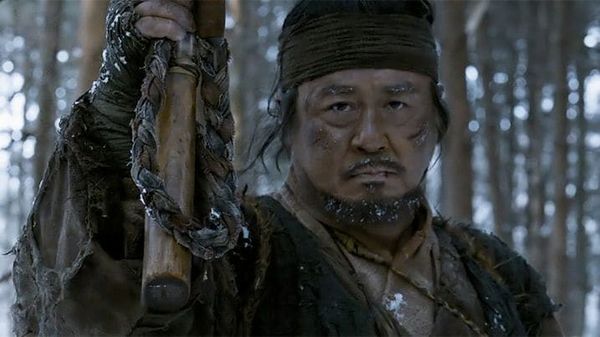Eye For Film >> Movies >> The Tiger (2015) Film Review

Today there are an estimated 500 Siberian tigers left in the wild. There are none in Korea. Though they once dominated the country's thickly wooded mountains, they were wiped out in the early 1940, during the final years of Japanese occupation. That was the period when taxidermied trophies and tiger skin rugs were the ultimate symbol of social superiority. This film follows one Japanese commander's attempt to bring down a 400kg, one-eyed tiger seen locally as the lord of the mountain.
Of course, said Japanese commander is neither skilled enough nor stupid enough to take on the task directly. Instead he puts a Korean-born underling in charge, using the man's ethnic heritage and fear of being labelled a traitor as leverage. The underling, in turn, pressures local hunters. The man they all want on the job is Man-duk (Choi Min-sik), a lifelong hunter believed to be the best shot in Korea. But despite having lost his wife to a tiger, Man-duk is curiously reluctant to get involved. His experiences have given him a deep respect for the natural law of the mountain - plus he has a secret that he shares only with the tiger himself.

The old hunter and the beleaguered yet powerful animal are paralleled in a film that doesn't hold back on traditional parallels between the tiger and the Korean people. The tiger is not merely a part of the mountain environment but a representative of it, and one of the most gut-wrenching scenes in the film sees the commander attempt to destroy it by taking on that environment itself. It's no accident that its high mountain perch gives it a view across tens of miles of the country, nor that the commander's obsession with it draws away troops who would otherwise be hunting pro-independence fighters. Both metaphorically and materially, the tiger is defending its country.
In Korean tradition, the tiger is one of the noblest, most revered of beasts, whilst hunters are social outcasts. As winter approaches and thick snow falls on the wolf-haunted woods, however, skill is all that counts. The tiger and Man-duk sit in their respective homes mourning for their loved ones and looking out at a changing world. The mountain grows thick with would-be warriors, but are there any who can rival either of them? Both are cautious strategists, mentally sharp, patient, potentially deadly. We don't really see what the tiger can do until halfway through the film, but when we do, it's spectacular.
The CGI here isn't perfect. The wolves, in particular, move unnaturally and too fast. The tiger's actions would feel more satisfying if they were more realistic and if it were less bulletproof, but there's a balance being struck between realism and the mythic quality essential to the tale. Despite their flaws, the action scenes are undoubtedly thrilling and very effective at persuading the viewer to take a side - a side which may change as the story develops.
There are some odd ideas here about tiger social behaviour, but individuals do vary, and this one is portrayed as believably animal despite its intelligence and complicated loyalties. Its sheer physical power is realistic and suitably awesome. Sometimes, says one of Mank-duk's friends, a mountain lord can become a god.
Despite its lack of subtlety and the sense that it needed to spend a little longer in post-production, this is a thriller in the truest sense. It's likely to really hit the spot with Korean viewers and there's plenty here to get others excited too. It's intelligent and moving and sometimes terrifying - something of a rarity in itself.
Reviewed on: 05 Nov 2017

















